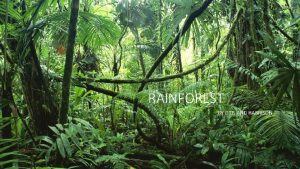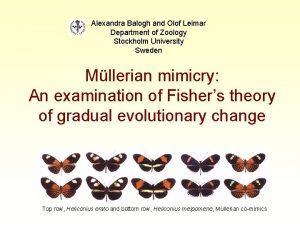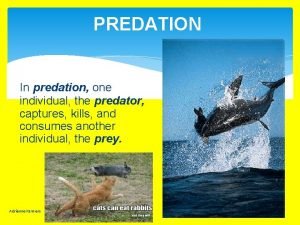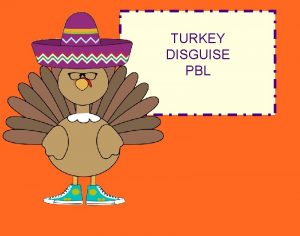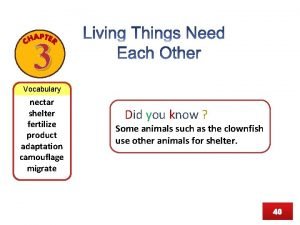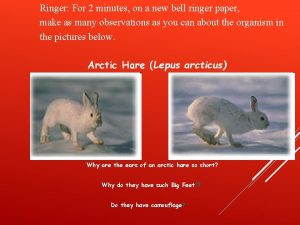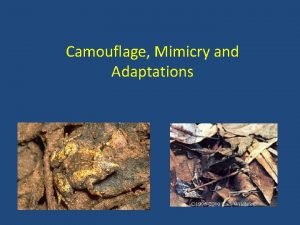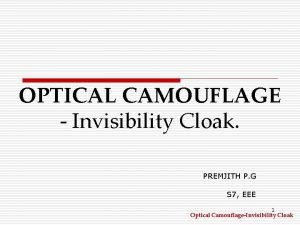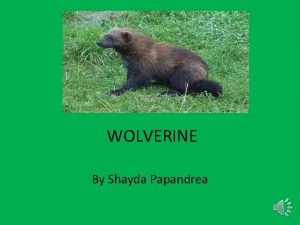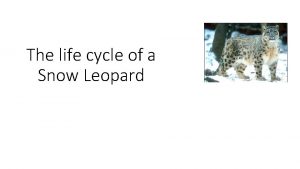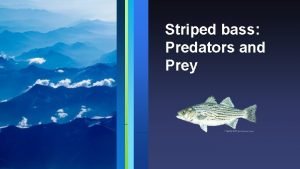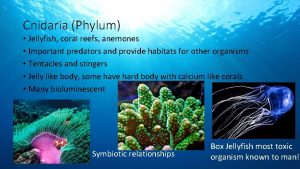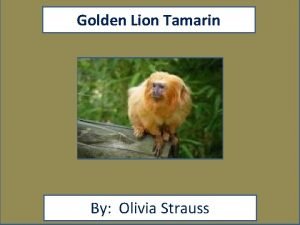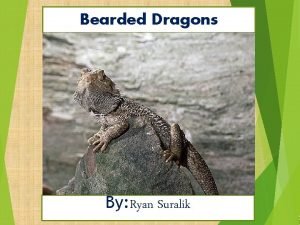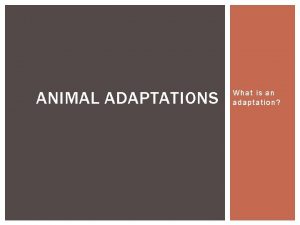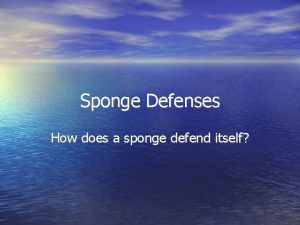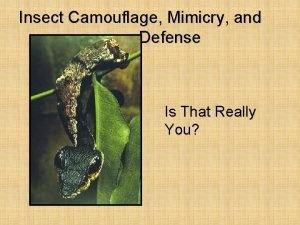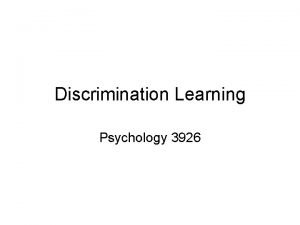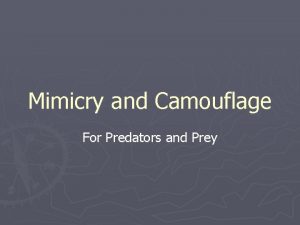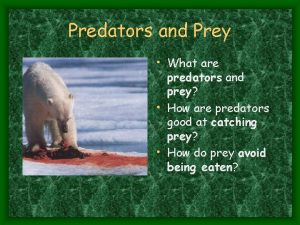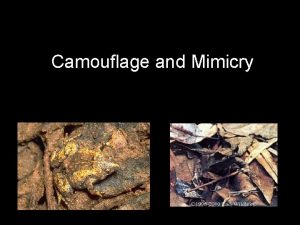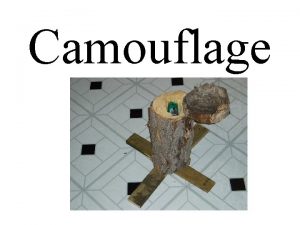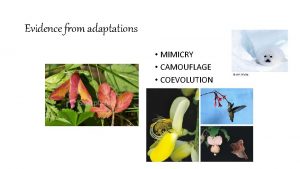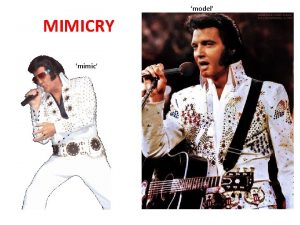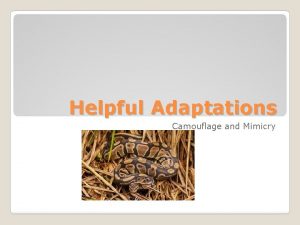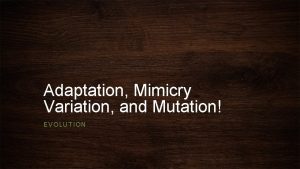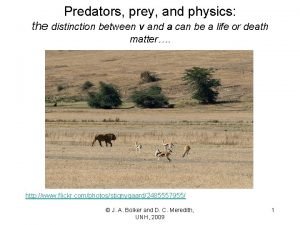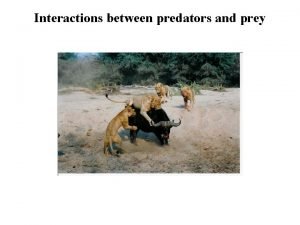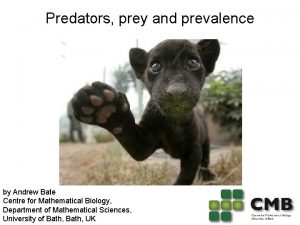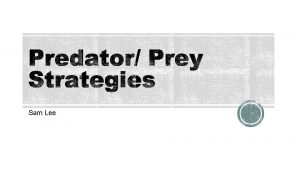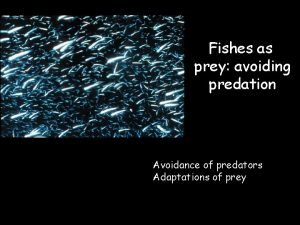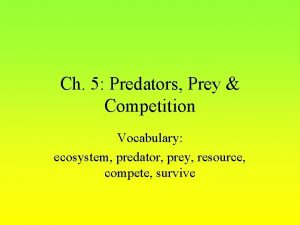Mimicry and Camouflage For Predators and Prey Mimicry





























- Slides: 29

Mimicry and Camouflage For Predators and Prey

Mimicry and Camouflage ►Mimicry is when 2 or more animal species look alike; ►camouflage refers to an animal that looks like its surroundings.

Batesian Mimicry Batesian mimicry refers to two or more species that are similar in appearance, but only one is dangerous The second species has no protection of its own, it just looks like the bad one

Example of Batesian mimicry ►Take a look at these two butterflies. One is a Monarch and very bad if eaten. The other is a Viceroy and very yummy. ►If an animal eats a Monarch butterfly and HATES it, it will stay away from ALL butterflies that look like Monarchs.


►Batesian mimicry is also found in venomous coral snakes and the harmless milk and king snakes. ►Both snakes are marked with alternating yellow, red, and black bands causing possible predators to avoid both. ►"Red against yellow: kill a fellow. Red against black: friend to Jack


Muellerian Mimicry ►two or more dangerous species look alike ►So all mimics share the benefits of the coloration since the predator will recognize the coloration of a dangerous group after a few bad experiences.

►Poison dart frogs of South America and Mantella frogs of Madagascar bright colors against black markings and toxic composition.

Examples of Muellerian Mimicry

►When Self mimicry an organism has a body part that looks like something else. ► Several turtle species and the Frogmouth Catfish have tongue extensions that are used as a sort of lure to attract prey ► The so-called "two-headed" snake of Central Africa which has a tail that resembles a head and a head that resembles a tail. The snake even moves its tail in the way most snakes move their heads




Self Mimicry ►"eye-spots“ are large dark markings that when flashed may momentarily startle a predator and allow the prey extra seconds to escape. ►"Eye-spots" also help prey escape predators by giving predators a false target. A butterfly has a better chance of surviving an attack to the outer part of its wing than an attack to the head.


Example of self-mimicry


CAMOUFLAGE ►A completely different approach for deception is camouflage, whereby animals seek to look inanimate or inedible to avoid detection by predators and prey. ► For example, the Uroplatus geckos of Madagascar are incredible masters of disguise and are practically unnoticeable to the passer-by.



Example ►Katydids are nocturnal insects which use their cryptic coloration to remain unnoticed during the day when they are inactive. ►Katydids have evolved to the point where their body coloring and shape matches leaves including half-eaten leaves, dying leaves, and leaves with bird droppings, sticks, twigs, and tree bark.




►Some species seem to stick out in their surroundings ►Others have spots or stripes to help break up the animal's outline. In the shade of the forest large mammals like leopards, jaguars, ocelots, and okapi are surprisingly difficult to see with their disruptive coloration.



interactive mimicry and camouflage
 What is the difference between mimicry and camouflage
What is the difference between mimicry and camouflage Kinkajou prey
Kinkajou prey Mullerian vs batesian mimicry
Mullerian vs batesian mimicry Prey adaptations to avoid predators
Prey adaptations to avoid predators Changing faces skin camouflage
Changing faces skin camouflage What is camouflage
What is camouflage Turkey in disguise pig
Turkey in disguise pig Gamequarium figurative language
Gamequarium figurative language Camouflage
Camouflage Camouflage animals
Camouflage animals What is camouflage
What is camouflage Bamboozle comparative and superlative
Bamboozle comparative and superlative Optical camouflage system
Optical camouflage system Homi bhabha of mimicry and man
Homi bhabha of mimicry and man Wolverine
Wolverine Snow leopard lifecycle
Snow leopard lifecycle Striped bass
Striped bass Keystone species define
Keystone species define Which energy
Which energy Cnidaria predators
Cnidaria predators Golden lion tamarin predators
Golden lion tamarin predators Bearded dragon predators
Bearded dragon predators What is an adaptions
What is an adaptions Is the solid portion of a comet a phrase or clause
Is the solid portion of a comet a phrase or clause Platypus predators
Platypus predators How does a sponge defend itself
How does a sponge defend itself Top predators in the savanna
Top predators in the savanna Object resemblance
Object resemblance Mullerian mimicry vs batesian
Mullerian mimicry vs batesian Discrimination learning psychology
Discrimination learning psychology

